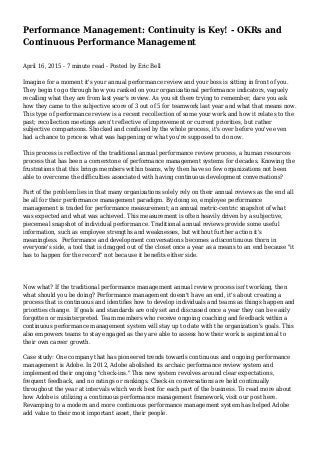
Performance Management: Continuity is Key! - OKRs and Continuous Performance Management
- 1. Performance Management: Continuity is Key! - OKRs and Continuous Performance Management April 16, 2015 - 7 minute read - Posted by Eric Bell Imagine for a moment it's your annual performance review and your boss is sitting in front of you. They begin to go through how you ranked on your organizational performance indicators, vaguely recalling what they are from last year's review. As you sit there trying to remember, dare you ask how they came to the subjective score of 3 out of 5 for teamwork last year and what that means now. This type of performance review is a recent recollection of some your work and how it relates to the past; recollection meetings aren't reflective of improvement or current priorities, but rather subjective comparisons. Shocked and confused by the whole process, it's over before you've even had a chance to process what was happening or what you're supposed to do now. This process is reflective of the traditional annual performance review process, a human resources process that has been a cornerstone of performance management systems for decades. Knowing the frustrations that this brings members within teams, why then have so few organizations not been able to overcome the difficulties associated with having continuous development conversations? Part of the problem lies in that many organizations solely rely on their annual reviews as the end all be all for their performance management paradigm. By doing so, employee performance management is traded for performance measurement; an annual metric-centric snapshot of what was expected and what was achieved. This measurement is often heavily driven by a subjective, piecemeal snapshot of individual performance. Traditional annual reviews provide some useful information, such as employee strengths and weaknesses, but without further action it's meaningless. Performance and development conversations becomes a discontinuous thorn in everyone's side, a tool that is dragged out of the closet once a year as a means to an end because "it has to happen for the record" not because it benefits either side. Now what? If the traditional performance management annual review process isn't working, then what should you be doing? Performance management doesn't have an end, it's about creating a process that is continuous and identifies how to develop individuals and teams as things happen and priorities change. If goals and standards are only set and discussed once a year they can be easily forgotten or misinterpreted. Team members who receive ongoing coaching and feedback within a continuous performance management system will stay up to date with the organization's goals. This also empowers teams to stay engaged as they are able to assess how their work is aspirational to their own career growth. Case study: One company that has pioneered trends towards continuous and ongoing performance management is Adobe. In 2012, Adobe abolished its archaic performance review system and implemented their ongoing "check-ins." This new system revolves around clear expectations, frequent feedback, and no ratings or rankings. Check-in conversations are held continually throughout the year at intervals which work best for each part of the business. To read more about how Adobe is utilizing a continuous performance management framework, visit our post here. Revamping to a modern and more continuous performance management system has helped Adobe add value to their most important asset, their people.
- 2. Transitioning To a Continuous Management Framework In order to establish a continuous performance management system there a three areas to focus on:
- 3. 1-on-1 Coaching - Providing team members with a voice through regular meetings with their direct supervisor or team lead to clarify expectations. Talking about what's working well and what, if any, areas of difficulty are being experienced will assist with personal development plans as well as tackle roadblocks on the day-to-day before they become huge problems. These sessions allow team members and their managers to stay in tune with each other's expectations. Ongoing Feedback - There should be constant communication regarding what goals and objectives are being reached and which ones are not. Feedback should be available at all times and not be reliant on having a scheduled 1-on-1 or an annual appraisal. Feedback is too often narrowly associated with the formal appraisal process between manager and direct report. Having a feedback process where anyone can seek out or give feedback allows individuals to gain multiple perspectives and grow in a collaborative environment. Employee Empowerment - Performance appraisals too often promote the false assumption that it is the organization or the supervisor who is responsible for an employee's development. In reality, it's the individual who is best situated to take ownership of his or her own developmental needs. By empowering your teams to take the lead on their own development they will seek out more timely feedback and be far more receptive to constructive feedback; it is always easier to provide negative feedback when it has been asked for and easier to accept when you've asked for it. Performance appraisals create a performance management system that is static and focused on a single event, the annual appraisal. In order to improve performance it is far more effective to have a continuous and ongoing system that can adapt and change as your team grows. A continuous and ongoing performance management system can limit surprises, boost employee retention, and mitigate any accompanying defensiveness individuals may have when perceiving feedback. Performance improvement/development is far more likely to occur when it is part of everyday life rather than at a predetermined date once or twice a year. Continuity is the key! Tags: 1-on-1 coaching, abolish performance appraisals, continuous performance management, employee engagement, ongoing feedback